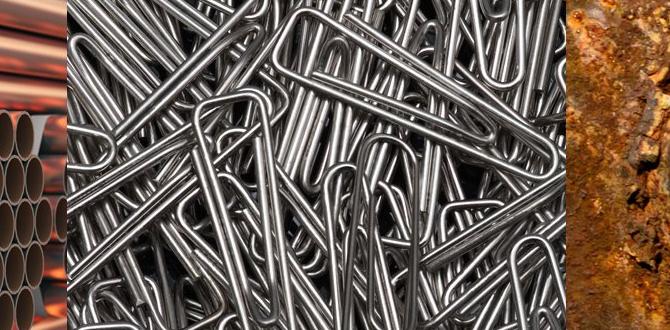A 1/8 inch carbide end mill is your go-to tool for precise cuts in various materials. It’s ideal for detailed work on CNC machines and manual mills, offering durability and accuracy for hobbyists and professionals alike.
Ever stared at a small project, needing a super-precise cut, and felt a bit lost? You’re not alone! Many of us start our machining journey with big dreams and a handful of basic tools. But when it comes to fine detail, especially in materials like aluminum, plastics, or even softer steels, a specific tool often rises to the top: the 1/8 inch carbide end mill. This little workhorse is incredibly versatile, and understanding it can open up a whole new world of possibilities for your workshop. Don’t worry if it sounds a bit technical; we’ll break it all down, step-by-step, just like we do with all our lathe and milling guides. Ready to tackle those intricate cuts with confidence?
Why a 1/8 Inch Carbide End Mill is a Must-Have
So, why all the fuss about a tiny 1/8 inch end mill? It boils down to precision, material versatility, and durability. In the expansive world of machining, having the right tool for the job isn’t just about making things easier; it’s about achieving the quality results you’re aiming for. For hobbyists and those new to CNC or manual milling, a smaller end mill like this one is often a gateway to more complex and delicate projects.
Think about the kind of work that demands a small, sharp cutting edge. Engraving intricate patterns, creating small fillets, cutting tiny slots, or machining detailed parts for robotics or models – these all require a tool that can navigate tight spaces with accuracy. A 1/8 inch end mill fits this bill perfectly. It allows for fine detail that larger tools simply can’t achieve without potentially hogging out too much material or damaging delicate features.
Carbide is also a significant factor in its popularity. Unlike High-Speed Steel (HSS) tools, carbide offers superior hardness and heat resistance. This means it can cut harder materials, run at faster speeds, and maintain its sharp edge for much longer. For busy workshops or for makers who want to spend more time cutting and less time changing tools, the longevity of carbide is a huge advantage. Combined with its small size, a 1/8 inch carbide end mill becomes an indispensable part of a well-equipped toolkit.
Understanding the Basics: Parts of an End Mill
Before we dive into using our 1/8 inch carbide end mill, let’s quickly get familiar with its anatomy. Knowing these few key parts will help you understand specifications and how the tool works. It’s like knowing the names of the parts of your lathe – it just makes things clearer!
- Shank: This is the part of the end mill that gets held by the collet or tool holder in your milling machine. Most 1/8 inch end mills will have a shank that matches common collet sizes, often a 1/4 inch (6.35mm) or sometimes an 8mm shank for increased rigidity, especially in metric setups. The shank needs to be clean and well-gripped to avoid runout (wobble) and ensure a stable cut.
- Flutes: These are the helical grooves that run up the cutting portion of the end mill. They serve two main purposes: they create the cutting edges, and they provide a channel for chips (the small pieces of material removed during cutting) to escape. End mills come with different numbers of flutes (2, 3, 4, or more), each suited for different materials and operations. For smaller end mills like our 1/8 inch, 2-flute or 4-flute designs are very common.
- Cutting Edge: This is the sharp part of the flute helix that actually removes material. The geometry of the cutting edge is critical to how efficiently and cleanly the end mill cuts.
- End Cutting Face: While not all end mills cut on their end face, many do. This allows them to plunge (drill straight down into the material) or create flat-bottomed pockets.
- Corner Radius: Some end mills have a slightly rounded corner instead of a sharp 90-degree edge. This is called a corner radius. It helps to strengthen the cutting edge and can leave a small fillet instead of a sharp internal corner in your workpiece, which is often desirable for stress distribution or aesthetic reasons.
Choosing Your 1/8 Inch Carbide End Mill: Key Features
When you go to buy a 1/8 inch carbide end mill, you’ll notice there are several options. Don’t let the variety overwhelm you! For beginners, focusing on a few key specifications will help you pick the right tool for most common tasks. We’re often looking for a reliable, general-purpose tool when starting out.
Number of Flutes
This is one of the most important considerations. The number of flutes affects chip clearance and the ability to cut different materials:
- 2-Flute: Excellent for softer materials like plastics, aluminum, and woods. The larger chip pockets allow for efficient chip evacuation, preventing clogging and overheating. These are often preferred for their versatility in common hobbyist materials.
- 4-Flute: Better suited for harder materials like steels and stainless steels. More flutes mean a smoother finish and less chatter (vibration) due to more cutting edges engaging the workpiece. However, they have smaller chip pockets, so they need careful consideration for feed rates and cooling, especially in softer, “gummy” materials.
For general-purpose use on a beginner’s machine, a 2-flute end mill is often a great starting point for plastics and aluminum. If you plan to tackle steels early on, research specific recommendations for those materials.
Coating
While not strictly necessary for all introductory tasks, coatings can significantly extend tool life and improve performance:
- Uncoated: The most basic option. Good for general-purpose use in softer materials if speeds and feeds are kept reasonable.
- TiN (Titanium Nitride): A common, general-purpose coating. It’s gold-colored and adds hardness, reducing friction and heat. Good for a wide range of materials.
- TiAlN (Titanium Aluminum Nitride): Excellent for higher-temperature applications and harder materials like steels. It forms an oxide layer that protects the tool at high heat.
For a beginner, an uncoated or TiN-coated 1/8 inch end mill will likely serve you well for common plastics and aluminum projects.
Overall Length and Shank Diameter
A standard length end mill is what most people start with. However, you might encounter “stub” or extra-long versions. For 1/8 inch end mills, a common shank diameter is 1/4 inch. If you’re using a machine with metric collets, an 8mm shank might be more common for stability, even though the cutting diameter is 1/8 inch (approx 3.175mm).
Corner Type
- Square End: Has a sharp 90-degree cutting edge at the tip and corners. Ideal for cutting slots, pockets, and profiling edges.
- Ball End: The tip is rounded, forming a half-sphere. Great for creating 3D contours, fillets, and rounded internal corners.
- Corner Radius: A square end with a small, defined radius at the corners. This adds strength to the cutting edge and leaves a small fillet, preventing stress risers.
For general-purpose milling and pocketing, a square end or a small corner radius (e.g., 0.010″ or 0.020″) is typically most useful.
Applications for Your 1/8 Inch End Mill
The 1/8 inch carbide end mill isn’t just a single-purpose tool; its small size and precision make it suitable for a surprisingly diverse range of tasks. Here’s where this little tool really shines:
- Detailed Engraving: Whether you’re adding text to a part, creating intricate designs, or marking components, a small end mill is essential for fine lines and details.
- Small Pocketing: Need to create a shallow recess for a component, a battery compartment, or a specific cavity? A 1/8 inch end mill handles these small pockets with ease.
- Slotting and Grooving: For making narrow slots for pins, keyways, or decorative grooves, this tool is perfect.
- Profiling and Contouring: Cutting out small parts or creating smooth, curved edges on delicate pieces is easily done with a small end mill.
- Working with Small Parts: Machining components for model airplanes, drones, miniature mechanisms, or jewelry often requires very small tools like the 1/8 inch end mill.
- Additive Manufacturing (3D Printing) Post-Processing: Sometimes 3D printed parts need post-machining to achieve tight tolerances or smooth surfaces. A small end mill can be used for this.
- Prototyping: When iterating on a design, you often need to quickly mill small features or test out part fits. The 1/8 inch end mill is a go-to for these rapid prototyping needs.
Consider the materials: This size of end mill is fantastic for plastics like ABS, acrylic, and nylon. It’s also excellent for aluminum alloys and is capable of cutting some softer steels, though harder steels will require slower speeds, careful feed rates, and good lubrication/cooling. For cutting nylon, a sharp, high-quality carbide end mill with good chip evacuation properties is key. The keyword “carbide end mill 1/8 inch 10mm shank standard length for nylon chip evacuation” highlights the importance of flute geometry for clearing nylon’s stringy chips.
Safety First! Essential Practices with Small End Mills
Working with any cutting tool requires respect for safety, and small end mills are no exception. While they might seem less intimidating than larger tools, a high-speed spinning piece of carbide can cause serious injury. Good shop practices are always paramount.
- Eye Protection: ALWAYS wear safety glasses or a face shield. Metal chips, even small ones, can fly at high speeds.
- Secure Workpiece: Ensure your workpiece is clamped down firmly. Unexpected tool forces can dislodge unsecured parts.
- Proper Work Holding: Use a clean collet or tool holder. Ensure the end mill is seated correctly and deeply enough in the holder. Avoid “chatter” caused by a loose tool.
- Machine Guarding: Keep machine guards in place. Never reach into the cutting area while the spindle is rotating.
- Start Slow: Especially when trying a new material or setup, start with conservative speeds and feeds. Listen to the machine and the cut.
- Chip Evacuation: Ensure chips are being cleared properly. Clogged chips can lead to overheating, tool breakage, or a poor finish. For materials like nylon, this is especially critical.
- Tool Length: Don’t let too much of the end mill shank stick out of the collet if you don’t need to. This increases the risk of deflection and breakage. Always use the shortest possible tool length for the job.
- Coolant/Lubrication: For some materials, coolant or a lubricant can help dissipate heat and improve chip evacuation, extending tool life.
The Occupational Safety and Health Administration (OSHA) provides extensive guidelines on machine guarding and safe operating procedures that are vital for any workshop. Familiarize yourself with these general safety principles.
Getting Started: Setting Up Your 1/8 Inch End Mill
Setting up your 1/8 inch end mill correctly is crucial for accurate cuts and a long tool life. It’s a straightforward process, but attention to detail makes a difference.
1. Select the Right Collet
Your milling machine uses collets to grip the end mill shank. For a 1/8 inch end mill, you’ll need a collet that matches its shank diameter and is also slightly larger than 1/8 inch to grip it effectively. Common shank sizes for 1/8 inch end mills are 1/4 inch or 6mm. Ensure your collet set includes this size.
2. Cleanliness is Key
Before inserting the end mill into the collet, make sure both the end mill shank and the inside of the collet are perfectly clean. Any swarf, oil, or debris can prevent a proper grip, leading to runout (wobble) and inaccurate cuts, or even cause the tool to slip.
3. Insert the End Mill
Place the end mill into the collet. Ensure it’s seated properly. You want enough of the shank inside the collet to provide a secure grip, but avoid sticking out excessively if not needed for the depth of cut. A good rule of thumb is to have at least 2-3 times the shank diameter engaged in the collet.
4. Tighten the Collet
Insert the collet along with the end mill into the milling machine’s spindle. Tighten the collet nut securely. Your machine’s manual will detail the correct torque or method for tightening your specific spindle and collet system.
5. Set Spindle Speed (RPM) and Feed Rate
This is where material choice becomes critical. For a 1/8 inch carbide end mill:
- Materials like Aluminum and Nylon: Often require higher spindle speeds (RPM) and moderate feed rates. For aluminum, speeds of 10,000-20,000+ RPM are common with a 1/8 inch end mill. For nylon, similar speeds but careful control over feed to manage chip evacuation are needed.
- Softer Plastics (e.g., Acrylic): Can also run at high speeds.
- Steels: Require much lower spindle speeds and often slower feed rates to prevent overheating and tool breakage. Speeds might range from 2,000-5,000 RPM depending on the steel type and machine rigidity.
Rule of Thumb for Speeds & Feeds: While precise numbers depend on many factors (machine rigidity, coolant, flute geometry), a good starting point for 1/8 inch carbide in aluminum might be around 15,000 RPM with a feed rate of 0.001 to 0.002 inches per revolution (IPR). For nylon, aim for similar RPM but slightly higher feed if chip evacuation is good – watch for melting! For steel, you’re looking at much lower RPM and feed rates, possibly 3,000 RPM with 0.0005 to 0.001 IPR. Always consult manufacturer recommendations or online calculators if available.
You can find helpful online calculators, like those from Iscar or similar cutting tool manufacturers, to get a good starting point for RPM and feed rate for specific materials.
6. Set the Z-Axis Zero
Accurately set your Z-axis zero point. This tells the machine where the top surface of your workpiece is, so it knows how deep to cut. Use a tool setter, a touch probe, or a piece of paper to find the top of your stock.
7. Perform a Dry Run
Before making the actual cut, run the program with the spindle off (or at a very low speed if your machine allows) to ensure the tool path clears the workpiece and any clamps/fixtures. Then, perform a “dry run” with the spindle on, but with the Z-axis set to rapidly move above the workpiece. This confirms speeds and feed rates feel right and motion is as expected.
Machining Techniques with Your 1/8 Inch End Mill
Now that your tool is set up, let’s explore some common machining techniques you can perform. These are foundational skills for many projects.
Pocketing
Pocketing involves removing material from a contained area to create a recess. For a 1/8 inch end mill, this is ideal for small pockets, battery compartments, or areas where components will sit.
Steps:
- Define the pocket boundaries in your CAM software (or manually if using a manual mill).
- Set the desired depth of the pocket.
- For efficient machining, use a “pocketing” or “adaptive clearing” strategy. This involves spiraling into the material or moving in a systematic pattern to remove material in passes, rather than just plunging straight down.
- For wider pockets, consider using the 1/8 inch end mill for a roughing pass and then a larger end mill for finishing, or perform a finishing pass with the 1/8 inch end mill along the boundary to achieve tight tolerances.
Profiling (Contour Machining)
Profiling is used to cut the outer shape of a part or to create internal contours. A 1/8 inch end mill is perfect for cutting out small parts.
Steps:
- Define the profile path in your







